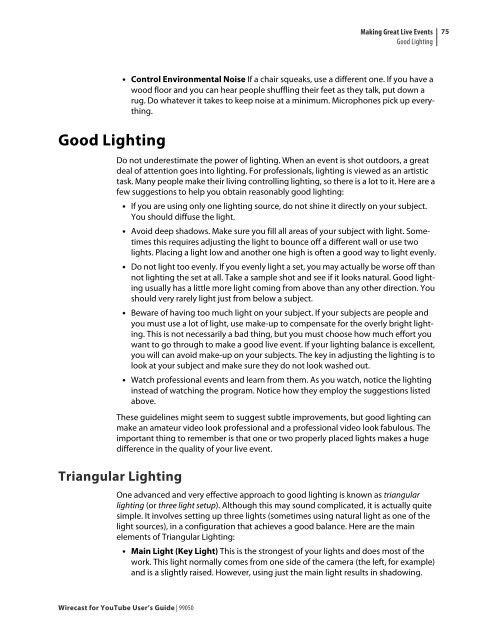You also want an ePaper? Increase the reach of your titles
YUMPU automatically turns print PDFs into web optimized ePapers that Google loves.
Good Lighting<br />
<strong>Wirecast</strong> <strong>for</strong> <strong>YouTube</strong> <strong>User</strong>’s <strong>Guide</strong> | 99050<br />
Making Great Live Events<br />
Good Lighting<br />
Control Environmental Noise If a chair squeaks, use a different one. If you have a<br />
wood floor and you can hear people shuffling their feet as they talk, put down a<br />
rug. Do whatever it takes to keep noise at a minimum. Microphones pick up everything.<br />
Do not underestimate the power of lighting. When an event is shot outdoors, a great<br />
deal of attention goes into lighting. For professionals, lighting is viewed as an artistic<br />
task. Many people make their living controlling lighting, so there is a lot to it. Here are a<br />
few suggestions to help you obtain reasonably good lighting:<br />
If you are using only one lighting source, do not shine it directly on your subject.<br />
You should diffuse the light.<br />
Avoid deep shadows. Make sure you fill all areas of your subject with light. Sometimes<br />
this requires adjusting the light to bounce off a different wall or use two<br />
lights. Placing a light low and another one high is often a good way to light evenly.<br />
Do not light too evenly. If you evenly light a set, you may actually be worse off than<br />
not lighting the set at all. Take a sample shot and see if it looks natural. Good lighting<br />
usually has a little more light coming from above than any other direction. You<br />
should very rarely light just from below a subject.<br />
Beware of having too much light on your subject. If your subjects are people and<br />
you must use a lot of light, use make-up to compensate <strong>for</strong> the overly bright lighting.<br />
This is not necessarily a bad thing, but you must choose how much ef<strong>for</strong>t you<br />
want to go through to make a good live event. If your lighting balance is excellent,<br />
you will can avoid make-up on your subjects. The key in adjusting the lighting is to<br />
look at your subject and make sure they do not look washed out.<br />
Watch professional events and learn from them. As you watch, notice the lighting<br />
instead of watching the program. Notice how they employ the suggestions listed<br />
above.<br />
These guidelines might seem to suggest subtle improvements, but good lighting can<br />
make an amateur video look professional and a professional video look fabulous. The<br />
important thing to remember is that one or two properly placed lights makes a huge<br />
difference in the quality of your live event.<br />
Triangular Lighting<br />
One advanced and very effective approach to good lighting is known as triangular<br />
lighting (or three light setup). Although this may sound complicated, it is actually quite<br />
simple. It involves setting up three lights (sometimes using natural light as one of the<br />
light sources), in a configuration that achieves a good balance. Here are the main<br />
elements of Triangular Lighting:<br />
Main Light (Key Light) This is the strongest of your lights and does most of the<br />
work. This light normally comes from one side of the camera (the left, <strong>for</strong> example)<br />
and is a slightly raised. However, using just the main light results in shadowing.<br />
75


